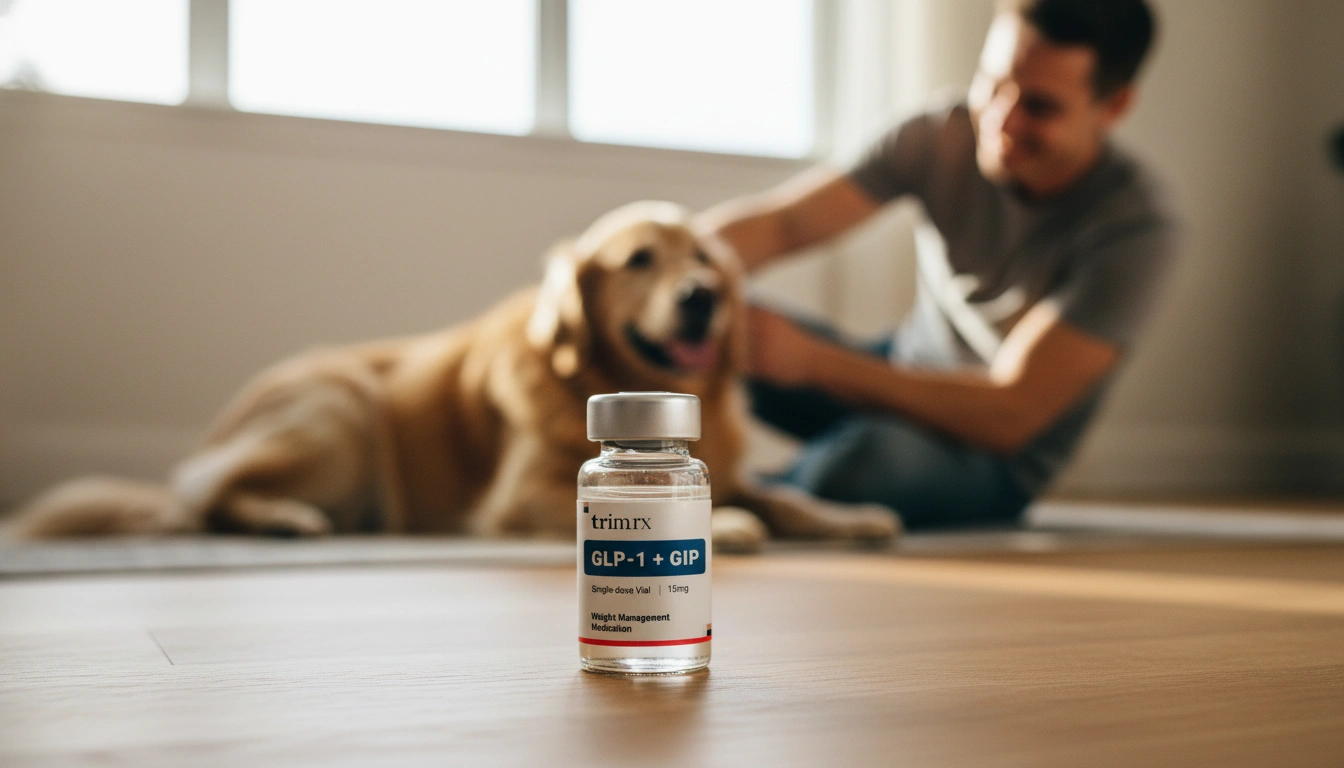How Long Does GLP-1 Nausea Last? Understanding and Managing This Side Effect

Nausea is a common experience for many individuals starting on glucagon-like peptide-1 (GLP-1) medications, such as Semaglutide and Tirzepatide, utilized for weight loss and diabetes management. If you’re among those who have embarked on this journey, you may find yourself asking: How long does GLP-1 nausea last, and what can I do to manage it?
At TrimRx, we understand the challenges that come with weight loss medications, including the discomfort of nausea. Our mission is to provide empathetic, innovative, and personalized support to help you navigate this journey. In this blog post, we will dive into the duration of nausea associated with GLP-1 medications, explore its causes, and offer actionable strategies to help alleviate this side effect while you pursue your weight loss goals.
Introduction
Did you know that nausea is reported by up to 20% of individuals taking GLP-1 medications? This side effect can often be discouraging, especially when you’re eager to experience the benefits of your weight loss journey. The reality is that while nausea can be a common occurrence, especially during the initial phases of treatment and after dosage increases, it is typically transient.
Understanding the timeline of nausea can empower you as you start your weight loss journey. In this post, we will explore the expected duration of nausea, the underlying mechanisms that cause it, and practical tips for managing this side effect effectively. By the end of this article, you will have a clearer understanding of what to expect and how to navigate nausea as part of your treatment plan.
We will cover:
- The duration of nausea associated with GLP-1 medications.
- Why GLP-1 medications cause nausea.
- Effective strategies to manage and reduce nausea.
- When to consult a healthcare professional regarding nausea.
By engaging with this content, you’ll equip yourself with the knowledge needed to tackle nausea head-on and focus on achieving your health goals with TrimRx’s support.
Understanding the Duration of Nausea with GLP-1 Medications
Common Timeframes
When beginning treatment with GLP-1 medications, many people experience nausea, particularly in the first few weeks. Based on clinical studies, nausea generally lasts anywhere from a few days to several weeks. Research indicates the following trends regarding nausea duration:
- Initial Onset: Nausea can start shortly after initiating treatment and is most intense during the first 8 to 12 weeks. This is typically when your healthcare provider may gradually increase your dosage.
- Peak Duration: A study highlighted that nausea often peaks around 20 weeks into treatment. However, most instances of nausea are reported to last about 8 days on average per episode.
- Adaptation Phase: For many individuals, nausea tends to improve as the body adjusts to the medication. After this initial adjustment period, many find that symptoms diminish significantly.
Individual Variability
It’s important to note that the experience of nausea can vary widely among individuals. Some may find their nausea subsides quickly, while others may experience it for a longer duration. Factors that contribute to this variability include:
- Dosage: Higher doses of GLP-1 medications are associated with increased likelihood and severity of nausea.
- Individual Sensitivity: Each person’s body reacts differently to medications, and some may be more sensitive to gastrointestinal side effects.
- Diet and Lifestyle: Dietary choices and overall health can also influence how nausea is experienced and managed.
Understanding these timeframes can help set realistic expectations as you begin your treatment with GLP-1 medications.
Why Does GLP-1 Cause Nausea?
The mechanism behind nausea associated with GLP-1 medications is not entirely understood, but several theories have been proposed:
1. Delayed Gastric Emptying
One of the primary reasons nausea occurs is due to the way GLP-1 medications affect gastric motility. These medications are designed to slow gastric emptying, meaning that food remains in the stomach longer, which can lead to feelings of fullness and nausea. While this can help prevent overeating, it can also trigger gastrointestinal discomfort.
2. Activation of GLP-1 Receptors
GLP-1 medications work by activating GLP-1 receptors in the brain and gastrointestinal tract, which can influence appetite and satiety. While this activation helps regulate blood sugar levels and reduce appetite, it may simultaneously induce feelings of nausea.
3. Psychological Factors
Starting a new medication often comes with anxiety and anticipation, which can further exacerbate feelings of nausea. The mind-body connection plays a significant role in how we perceive and experience physical symptoms.
4. Gastrointestinal Sensitivity
Individuals with pre-existing gastrointestinal sensitivities or conditions may experience heightened nausea when starting GLP-1 medications. This is important to consider when evaluating your experience.
While understanding the causes of nausea can make it less daunting, it’s essential to recognize that there are effective strategies we can implement together at TrimRx to manage this side effect.
Effective Strategies to Manage Nausea from GLP-1 Medications
1. Start Low and Go Slow
One of the keys to managing nausea is to begin your treatment at a lower dose and gradually increase it as tolerated. This approach allows your body to adapt to the medication more comfortably. Our team at TrimRx is here to guide you through this process, ensuring that your dosage is personalized to your needs.
2. Dietary Modifications
Making small changes to your diet can significantly reduce nausea. Here are some suggestions:
- Eat Smaller, More Frequent Meals: Instead of three large meals, aim for smaller, more frequent meals throughout the day to avoid overwhelming your stomach.
- Avoid Trigger Foods: High-fat and greasy foods may exacerbate nausea. Opt for bland foods that are easier to digest, such as rice, toast, or crackers.
- Stay Hydrated: Drinking small sips of water throughout the day can help keep you hydrated without overwhelming your stomach. Avoid drinking large amounts of fluids during meals.
3. Monitor Food Intake
Consider keeping a food diary to identify any potential food triggers that may worsen nausea. Note what you eat, how much, and when you experience nausea. This can help you make informed dietary choices moving forward.
4. Consider Anti-Nausea Medications
If nausea persists, consult with your healthcare provider about the possibility of using anti-nausea medications like Ondansetron (Zofran). This medication can provide relief while your body adjusts to GLP-1 therapy. At TrimRx, we offer comprehensive support, including consultations to discuss medication options tailored to your needs.
5. Relax and Manage Stress
Practice relaxation techniques, such as deep breathing, meditation, or gentle yoga, to help manage any anxiety or stress that may exacerbate nausea.
6. Stay Active
While vigorous exercise may not be advisable immediately after meals, gentle activities like walking can aid digestion and help alleviate nausea.
7. Seek Support
Don’t hesitate to reach out to your TrimRx healthcare provider if you are struggling with nausea. We are here to support you and can help you evaluate your treatment plan, making necessary adjustments as needed.
When to Consult a Healthcare Professional
While nausea is a common side effect of GLP-1 medications, it’s essential to monitor your symptoms closely. Contact your healthcare provider if you experience:
- Severe or persistent nausea that disrupts your daily activities.
- Nausea accompanied by additional symptoms, such as severe abdominal pain, vomiting, or signs of dehydration.
- Concerns about pancreatitis, characterized by severe abdominal pain that may radiate to the back, along with nausea and vomiting.
Your health and well-being are our top priorities at TrimRx, and we want to ensure that your weight loss journey is safe and effective.
Conclusion
In summary, nausea is a common side effect associated with GLP-1 medications, often lasting from a few days to several weeks as your body adjusts to the treatment. By understanding the duration and causes of nausea, as well as implementing effective management strategies, you can navigate this side effect with greater ease.
At TrimRx, we are dedicated to providing personalized support and guidance throughout your weight loss journey. If you are just beginning your treatment or are experiencing challenges with nausea, we encourage you to take our free assessment quiz to determine your eligibility for our personalized weight loss programs and gain access to the resources you need.
Ready to take the next step? Take our free assessment quiz to learn more about your options.
FAQ
How long does nausea last with GLP-1 medications?
Nausea typically lasts between a few days to several weeks, with an average duration of about 8 days for individual episodes. It is most common during the first 8 to 12 weeks of treatment.
What causes nausea when taking GLP-1 medications?
Nausea can be caused by delayed gastric emptying, activation of GLP-1 receptors in the central nervous system, and individual gastrointestinal sensitivities.
How can I manage nausea from GLP-1 medications?
Effective strategies include starting at a lower dose, eating smaller meals, avoiding trigger foods, staying hydrated, and considering anti-nausea medications if necessary.
When should I contact my healthcare provider about nausea?
Consult your healthcare provider if you experience severe or persistent nausea, nausea accompanied by severe abdominal pain, or other concerning symptoms.
What support does TrimRx offer for managing side effects?
At TrimRx, we provide personalized consultations, dietary guidance, and support for managing side effects, ensuring that your weight loss journey is safe and effective.

Transforming Lives, One Step at a Time
Keep reading
Vitamin B12 and GLP-1 Medications: What to Know
GLP-1 medications can lower B12 absorption and intake; learn symptoms, food sources, supplement options, and how to monitor levels.
Semaglutide Injection Site Reactions: What To Know
Learn why semaglutide injections can cause redness, swelling or nodules, how to prevent and treat them, and when to seek medical care.
TrimRx vs Friday’s
Compare TrimRx and Friday’s telehealth GLP-1 weight-loss programs: pricing, medical support, coaching, delivery, and which fits your needs.



